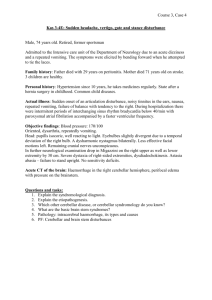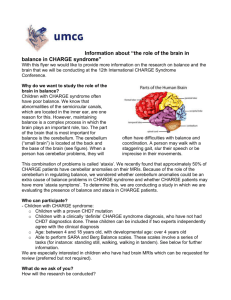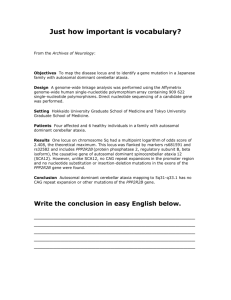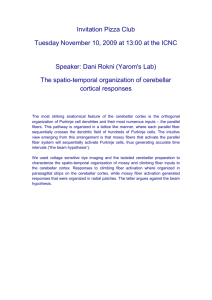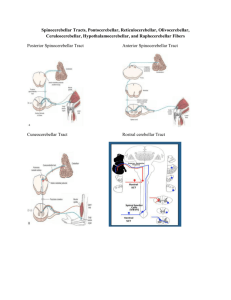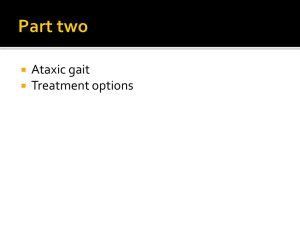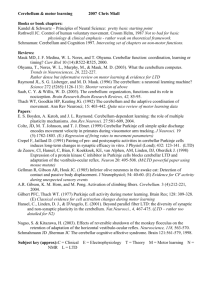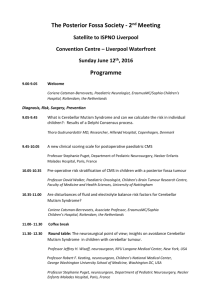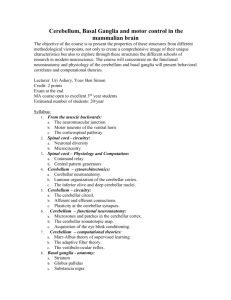Cerebellum (updated 11
advertisement
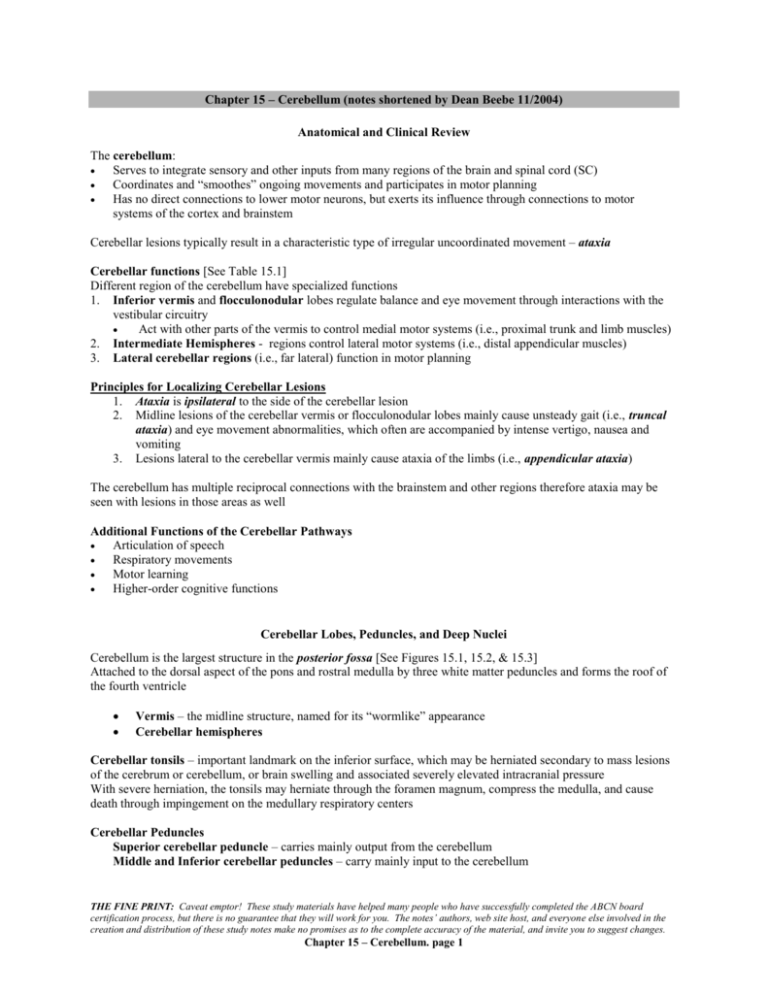
Chapter 15 – Cerebellum (notes shortened by Dean Beebe 11/2004) Anatomical and Clinical Review The cerebellum: Serves to integrate sensory and other inputs from many regions of the brain and spinal cord (SC) Coordinates and “smoothes” ongoing movements and participates in motor planning Has no direct connections to lower motor neurons, but exerts its influence through connections to motor systems of the cortex and brainstem Cerebellar lesions typically result in a characteristic type of irregular uncoordinated movement – ataxia Cerebellar functions [See Table 15.1] Different region of the cerebellum have specialized functions 1. Inferior vermis and flocculonodular lobes regulate balance and eye movement through interactions with the vestibular circuitry Act with other parts of the vermis to control medial motor systems (i.e., proximal trunk and limb muscles) 2. Intermediate Hemispheres - regions control lateral motor systems (i.e., distal appendicular muscles) 3. Lateral cerebellar regions (i.e., far lateral) function in motor planning Principles for Localizing Cerebellar Lesions 1. Ataxia is ipsilateral to the side of the cerebellar lesion 2. Midline lesions of the cerebellar vermis or flocculonodular lobes mainly cause unsteady gait (i.e., truncal ataxia) and eye movement abnormalities, which often are accompanied by intense vertigo, nausea and vomiting 3. Lesions lateral to the cerebellar vermis mainly cause ataxia of the limbs (i.e., appendicular ataxia) The cerebellum has multiple reciprocal connections with the brainstem and other regions therefore ataxia may be seen with lesions in those areas as well Additional Functions of the Cerebellar Pathways Articulation of speech Respiratory movements Motor learning Higher-order cognitive functions Cerebellar Lobes, Peduncles, and Deep Nuclei Cerebellum is the largest structure in the posterior fossa [See Figures 15.1, 15.2, & 15.3] Attached to the dorsal aspect of the pons and rostral medulla by three white matter peduncles and forms the roof of the fourth ventricle Vermis – the midline structure, named for its “wormlike” appearance Cerebellar hemispheres Cerebellar tonsils – important landmark on the inferior surface, which may be herniated secondary to mass lesions of the cerebrum or cerebellum, or brain swelling and associated severely elevated intracranial pressure With severe herniation, the tonsils may herniate through the foramen magnum, compress the medulla, and cause death through impingement on the medullary respiratory centers Cerebellar Peduncles Superior cerebellar peduncle – carries mainly output from the cerebellum Middle and Inferior cerebellar peduncles – carry mainly input to the cerebellum THE FINE PRINT: Caveat emptor! These study materials have helped many people who have successfully completed the ABCN board certification process, but there is no guarantee that they will work for you. The notes’ authors, web site host, and everyone else involved in the creation and distribution of these study notes make no promises as to the complete accuracy of the material, and invite you to suggest changes. Chapter 15 – Cerebellum. page 1 Table 15.1 – Functional Regions of the Cerebellum REGION Lateral hemispheres (largest part of the cerebellum) Intermediate hemispheres Vermis Flocculonodular lobe FUNCTIONS Motor planning for extremities MOTOR PATHWAYS INFLUENCED Lateral corticospinal tract Distal limb coordination (especially the appendicular muscles in the legs & arms) Proximal limb and trunk coordination Lateral corticospinal tract & rubrospinal tract Balance and vestibulo-ocular reflexes Medial longitudinal fasciculus Anterior corticospinal tract, reticulospinal tract, vestibulospinal tract, & tectospinal tract Cerebellar Output Pathways Output pathways are organized around the three functional regions of the cerebellum: 1. Lateral hemispheres 2. Intermediate hemispheres 3. Vermis plus flocculonodular lobe Lesion Location Lateral cerebellum Medial cerebellum Functional Impact Distal limb coordination Trunk control, posture, balance, & gait Important Note: Deficits in coordination occur ipsilateral to the lesion Pathways from the cerebellum to the lateral motor systems and then to the periphery are “double crossed” 1st crossing occurs as the cerebellar output pathways exit in the decussation of the superior cerebellar peduncle 2nd crossing occurs as the corticospinal and rubrospinal tracts descend to the SC Inputs also follow this pattern, so each cerebellar hemisphere receives information about the ipsilateral limbs Midline lesions of the cerebellar vermis Affect the medial motor systems Do not typically cause unilateral deficits because the medial motor systems influence the proximal trunk muscles bilaterally Cerebellar Input Pathways Input to the cerebellum: Arises from: All areas within the CNS Multiple sensory modalities (e.g., vestibular, visual, auditory & somatosensory systems) Brainstem nuclei Spinal cord Is somatotopically organized, with the ipsilateral body represented in both the anterior and posterior lobes Major source consists of corticopontine fibers (i.e., from frontal, temporal, parietal & occipital lobes) that travel in the internal capsule and cerebral peduncles o Derive from primary sensory and motor cortices and part of the visual cortex o Travel to the ipsilateral pons and synapse in the pontine nuclei o Pontocerebellar fibers cross the midline to enter the contralateral middle cerebellar peduncle and give rise to mossy fibers that innervate much of the cerebellar cortex THE FINE PRINT: Caveat emptor! These study materials have helped many people who have successfully completed the ABCN board certification process, but there is no guarantee that they will work for you. The notes’ authors, web site host, and everyone else involved in the creation and distribution of these study notes make no promises as to the complete accuracy of the material, and invite you to suggest changes. Chapter 15 – Cerebellum. page 2 Spinocerebellar fibers comprise another major source of cerebellar input o Spinocerebellar tracts provide afferent information to the cerebellum Information about limb movements conveyed by the dorsal spinocerebellar tract and the cuneocerebellar tract Note: Spinocerebellar input is either ipsilateral or “double-crossed” ipsilateral limb ataxia when lesioned Vascular Supply to the Cerebellum [See Figures 15.12 & 15.13] Blood supply to the cerebellum is provided by three branches of the vertebral and basilar arteries: 1. Posterior inferior cerebellar artery (PICA), which arises from the vertebral artery 2. Anterior inferior cerebellar artery (AICA), which arises from the lower basilar artery 3. Superior cerebellar artery (SCA), which arises from the top of the basilar artery In addition to supplying the cerebellum, these arteries course through the brainstem, providing blood to portions of the lateral medulla and pons Cerebellar Artery Infarcts and Cerebellar Hemorrhage – Key Clinical Concept Infarcts are more common in the PICA and SCA than in the AICA territory Characteristic Symptom Pattern for Cerebellar Infarcts Vertigo Nausea and vomiting Horizontal nystagmus Limb ataxia Unsteady gait Headache (localized to occipital, frontal, or upper cervical regions) Note: Many of the signs and symptoms of cerebellar artery infarct result from infarction of the lateral medulla or pons, rather than the cerebellum - Infarcts of these areas may cause trigeminal and spinothalamic sensory loss, and Horner’s syndrome Conversely, infarcts of the lateral medulla or pons can cause ataxia because of involvement with cerebellar peduncles, even if the cerebellum is spared Infarct Patterns Infarcts that spare the brainstem and involve predominantly the cerebellum are more common with SCA infarcts than with PICA or AICA, therefore infarcts causing unilateral ataxia with little or no brainstem signs are most commonly in the SCA territory Infarcts of the PICA and AICA more often involve both the lateral brainstem and cerebellum Infarcts of the lateral pons or medulla that spare the cerebellum typically occur with PICA or AICA rather than SCA Large cerebellar infarcts that involve the territories of the PICA or SCA can cause swelling of the cerebellum Subsequent compression of the fourth ventricle can cause hydrocephalus Compression in the posterior fossa may be life threatening because the respiratory centers and other vital brainstem structures may be affected Treatment – surgical decompression and resection of portions of the infracted cerebellum Hemorrhage into the cerebellar white matter also can cause brainstem compression THE FINE PRINT: Caveat emptor! These study materials have helped many people who have successfully completed the ABCN board certification process, but there is no guarantee that they will work for you. The notes’ authors, web site host, and everyone else involved in the creation and distribution of these study notes make no promises as to the complete accuracy of the material, and invite you to suggest changes. Chapter 15 – Cerebellum. page 3 Cerebellar hemorrhage: Can occur secondary to: chronic hypertension arteriovenous malformation hemorrhagic conversion of an ischemic infarct metastases Symptom Presentation with cerebellar hemorrhage: headache nausea vomiting ataxia nystagmus Large cerebellar hemorrhages may cause: hydrocephalus [treated with ventriculostomy] 6th nerve palsies impaired consciousness brainstem compression death Treatment May include surgical evacuation of the hemorrhage and decompression of the posterior fossa Hydrocephalus treated by ventriculostomy carries with it the risk of upward transtentorial herniation Clinical Findings and Localization of Cerebellar Ataxia – Key Clinical Concepts Ataxia Means literally “lack of order” Refers to the disordered contractions of the agonist and antagonist muscles and lack of normal coordination between movements at different joints Characterized by movements that have an irregular, wavering course that seems to consist of continuous overshooting, overcorrecting and then overshooting again around the intended trajectory Characteristics of Ataxic Movements Dysrhythmia or abnormal timing Dysmetria or abnormal trajectories through space Truncal ataxia versus appendicular ataxia Truncal ataxia Caused by lesions confined to the cerebellar vermis Affect primarily the medial motor systems Lead to wide-based, unsteady, or “drunk like” gait or truncal ataxia In severe cases, patients may even have difficulties sitting up without support Appendicular ataxia Caused by lesions of the intermediate and lateral portions of the cerebellum Affect the lateral motor systems Cause ataxia on movement of the extremities Note: Lesions often extend to include both the vermis & cerebellar hemispheres and truncal and appendicular symptoms may coexist. More severe and longer-lasting deficits may occur with lesions of the intermediate hemisphere, vermis, deep nuclei, and cerebellar peduncles Unilateral lesions in the medial portion of the cerebellar hemisphere may produce no appreciable deficit THE FINE PRINT: Caveat emptor! These study materials have helped many people who have successfully completed the ABCN board certification process, but there is no guarantee that they will work for you. The notes’ authors, web site host, and everyone else involved in the creation and distribution of these study notes make no promises as to the complete accuracy of the material, and invite you to suggest changes. Chapter 15 – Cerebellum. page 4 Ipsilateral Localization of Ataxia Cerebellar connections involved in the lateral motor system are either ipsilateral or cross twice (i.e., “double crossed’) between the cerebellum and SC Lesions of the cerebellar hemispheres cause ataxia in the extremities ipsilateral to the side of the lesion Lesions of the cerebellar peduncles lead to ipsilateral ataxia In contrast: cerebellar lesions affecting the medial motor system cause truncal ataxia, which is a bilateral disorder, but patients with truncal ataxia often fall or sway toward side of lesion False Localization of Ataxia Ataxia may be caused by lesions to the cerebellar input or output pathways located outside the cerebellum Lesions in the cerebellar peduncles or pons (without damage to the cerebellar hemisphere) severe ataxia Hydrocephalus [which may damage frontopontine pathways] and lesions within the prefrontal cortex gait abnormalities similar to truncal ataxia Disorders of the SC gait abnormalities Ataxia-hemiparesis Syndrome caused by lacunar infarcts Presentation includes a combination of unilateral motor neuron signs and ataxia, usually affecting the same side Both the ataxia and hemiparesis are contralateral to the lesion side Most often caused by lesions in the: corona radiata, internal capsule or pons that involve both corticospinal and corticopontine fibers May also follow lesions in the: Frontal lobes Parietal lobes Sensorimotor cortex or Midbrain lesions that involve fibers of the superior cerebellar peduncle or red nucleus Sensory Ataxia Occurs when the posterior column – medial lemniscal pathway is disrupted Causes impaired or loss of joint position sense [not typically observed in cerebellar patients] Characterized by ataxic-appearing overshooting movements of the limbs and a wide-based, unsteady gait [similar to cerebellar involvement] May improve significantly with visual feedback Worsens with eyes closed or in the dark Typically involves lesions of the peripheral nerves or posterior columns ipsilateral ataxia May occur secondary to lesions in the thalamus, thalamic radiations or somatosensory cortex contralateral ataxia Symptoms and Signs of Cerebellar Disorders Nausea Vomiting Vertigo Slurred speech Unsteadiness Uncoordinated limb movements Headache (occurring in the frontal, occipital, or upper cervical regions) usually occurs on the side of the lesion Lesions that produce incipient tonsilar herniation may cause: Depressed consciousness Brainstem findings Hydrocephalus Head tilt [also seen with lesions to the anterior medullary velum] THE FINE PRINT: Caveat emptor! These study materials have helped many people who have successfully completed the ABCN board certification process, but there is no guarantee that they will work for you. The notes’ authors, web site host, and everyone else involved in the creation and distribution of these study notes make no promises as to the complete accuracy of the material, and invite you to suggest changes. Chapter 15 – Cerebellum. page 5 Abnormalities that Can Confound the Cerebellar Exam Upper Motor Neuron Signs Both corticospinal and cerebellar lesions can cause slow, clumsy, movements of the extremities Lower Motor Neuron Signs With severe upper or lower motor weakness, cerebellar testing may not be possible Precision finger tapping may be helpful, as cerebellar involvement typically causes the tip of the finger to hit a different spot on the thumb each time [See neuroexam.com Video 63] Sensory loss Loss of joint position sense can cause sensory ataxia Loss of position sense must be severe and sensory ataxia usually improves with visual feedback Basal ganglia dysfunction Movement disorders (e.g., parkinsonism) associated with basal ganglia involvement can cause slow, clumsy movements or gait unsteadiness Tremor and dyskinesia also may confound the cerebellar examination Most abnormalities can be described as a combination of: Dysmetria Abnormal undershoot or overshoot (i.e., past pointing) during movements toward a target Dysrhythmia Abnormal rhythm and timing of movements Tests for Ataxia 1. Finger-nose-finger test [See Figure 15.14 and neuroexam.com Video 64] Patient alternately touches her nose and then the examiner’s finger Sensitivity of the test may be increased by holding the target finger at the limit of the patient’s reach or by moving the target finger to a different position each time the patient touches her nose 2. Heel-shin test [see neuroexam.com Video 65] Patient rubs his heel up and down the length of his shin in as straight a line as possible Performed in the supine position to decrease contribution of gravity Variations include tapping the heel repeatedly on the same spot just below the knee or having the patient alternately touch his knee and the examiner’s finger Rapid tapping of the fingers together, hand on the thigh, or foot on the floor are good tests for dysrhythmia [see neuroexam.com Videos 52 & 53] Dysdiadochokinesia (aka adiadochokinesia) – abnormalities of rapid alternating movements, such as tapping one hand with the palm and dorsum of the other hand Testing for Overshoot or Loss of Check Have patient raise both arms suddenly from their lap or lower them suddenly to the level of the examiner’s hand [see neuroexam.com Video 66] or Apply pressure to the patient’s outstretched arms and suddenly release it Testing for Truncal Ataxia Wide-based, unsteady gait that resembles the drunk or toddler may be observed with cerebellar involvement (alcohol impairs cerebellar function and the cerebellar pathways of toddlers is not fully myelinated) 1. Tandem gait testing The patient is instructed to touch the heel with the toe of the other foot on each step, which forces the patient to assume a narrow stance Patients will fall or deviate toward the side of the lesion [see neuroexam.com Video 68] THE FINE PRINT: Caveat emptor! These study materials have helped many people who have successfully completed the ABCN board certification process, but there is no guarantee that they will work for you. The notes’ authors, web site host, and everyone else involved in the creation and distribution of these study notes make no promises as to the complete accuracy of the material, and invite you to suggest changes. Chapter 15 – Cerebellum. page 6 2. Romberg or Romberg’s test Patient is asked to stand with feet together for half a minute, then asked to close eyes A positive Romberg’s test occurs if the patient can stand with eyes open, but falls when they are closed Indicates a proprioceptive lesion and is NOT a test of cerebellar function With midline cerebellar lesions, the patient has difficulty standing with eyes open as well as closed [with these lesions, a peculiar tremor of the trunk or head, titubation, also can occur] May help differentiate cerebellar lesions from lesions of the vestibular or proprioceptive systems [See neuroexam.com Video 67] Eye Movement abnormalities Ocular dysmetria – saccades overshoot or undershoot their target Slow saccades [present in some degenerative disorders involving the cerebellum] Nystagmus, typically of the gaze paretic type in which the patient looking toward a target in the periphery exhibits slow phases toward the primary position and fast phases occur back toward the target May change directions depending upon the direction of gaze [unlike peripheral vertigo] Vertical nystagmus may occur Speech Abnormalities Scanning or explosive speech – an individual’s speech may have an ataxic quality in cerebellar disorders with irregular fluctuations in both rate and volume Cerebellar dysfunction also may cause slurring or articulatory problems Other Findings Cerebellar disease may cause; Decreased muscle tone “Pendular” reflexes Cognitive disturbance Differential Diagnosis of Ataxia – Key Clinical Concept Differential diagnosis depends on: the age of the patient and the time course of evolution of the ataxia Most Common Causes of Acute Ataxia in Adults: Toxin ingestion Ischemic or hemorrhagic stroke Most Common Causes of Chronic Ataxia in Adults: Brain metastases Chronic toxin exposure (especially to alcohol) Multiple sclerosis Degenerative disorders of the cerebellum or cerebellar pathways Most Common Causes of Acute Ataxia in Pediatric Patients: Accidental drug ingestion Varicella-associated cerebellitis Migraine Most Common Causes of Chronic or Progressive Ataxia in Pediatric Patients: Cerebellar astrocytoma Medulloblastoma Friedreich's ataxia Ataxia-telangiectasia THE FINE PRINT: Caveat emptor! These study materials have helped many people who have successfully completed the ABCN board certification process, but there is no guarantee that they will work for you. The notes’ authors, web site host, and everyone else involved in the creation and distribution of these study notes make no promises as to the complete accuracy of the material, and invite you to suggest changes. Chapter 15 – Cerebellum. page 7 Brief Anatomical Study Guide Cerebellum: located in the posterior fossa consists of: o midline vermis o intermediate part of the cerebellar hemisphere o lateral part of the cerebellar hemisphere attached to the brainstem by the: o superior cerebellar peduncle o middle cerebellar peduncle o inferior cerebellar peduncle Outputs of the Cerebellum All are carried by the deep cerebellar nuclei and the vestibular nuclei The cerebellar cortex and the deep nuclei can be divided into three functional zones: 1. Vermis (via fastigial nuclei) and flocculonodular lobes (via vestibular nuclei) Function in the control of proximal and trunk muscles and vestibulo-ocular control, respectively 2. Intermediate part of the cerebellar hemisphere (via interposed nuclei) Functions in the control of more distal appendicular muscles mainly in the arms and legs 3. Lateral part of the cerebellar hemisphere (via the dentate nuclei) Largest part of the cerebellum Involved in planning the motor program for the extremities Local cerebellar neurons Granule cells Inhibitory cells o Golgi cells o Basket cells o Stellate cells Cerebellar input and output pathways Form a complex system Follow a medial-lateral organization and all pathways to the lateral motor systems are either ipsilateral or double crossed so that cerebellar lesions cause ipsilateral deficits Ataxia Characteristic irregular movement abnormalities seen in cerebellar disorders Principles of Localizing Cerebellar Lesions [based on anatomical organization of the cerebellar pathways] 1. Ataxia is ipsilateral to the side of the cerebellar lesion 2. Midline lesions of the cerebellar vermis or flocculonodular lobes cause mainly unsteady gait (i.e., truncal ataxia) and eye movement abnormalities 3. Lesions of the intermediate part of the cerebellar hemisphere cause mainly ataxia of the limbs (i.e., appendicular ataxia) 4. Ataxia is often caused by lesions of the cerebellar circuitry in the brainstem or other locations rather than in the cerebellum itself, which can lead to false localization Because of the strong reciprocal connection between the cerebellum and vestibular system, cerebellar lesions often are associated with: Vertigo Nausea Vomiting Nystagmus THE FINE PRINT: Caveat emptor! These study materials have helped many people who have successfully completed the ABCN board certification process, but there is no guarantee that they will work for you. The notes’ authors, web site host, and everyone else involved in the creation and distribution of these study notes make no promises as to the complete accuracy of the material, and invite you to suggest changes. Chapter 15 – Cerebellum. page 8
